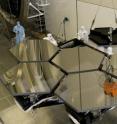Mirror testing at NASA breaks superstitious myths
In ancient mythological times reflective surfaces like shiny metals and mirrors were thought to be magical and credited with the ability to look into the future. NASA is using mirrors to do just the opposite – look into the past. Fast forward a couple of centuries from ancient time and myths to find NASA is developing a primary mirror, 21.3 feet in diameter, for use on the James Webb Space Telescope in a very different way -- to tell us about our beginning in the universe and how the first galaxies formed. The primary mirror will serve as the telescope's eye and peer through dusty clouds to see stars forming planetary systems, connecting the Milky Way to our own Solar System.
Handling delicate space hardware holds no superstitious myths for NASA, but it's still a delicate task that requires careful preparation. On Friday, Jan. 8, six of the 18 Webb telescope mirror segments will be moved into the X-ray and Cryogenic Facility, or XRCF, at NASA's Marshall Space Flight Center in Huntsville, Ala., to eventually experience temperatures dipping to a chilling -414 degrees Fahrenheit to ensure they can withstand the extreme space environments.
When the primary mirror is assembled in space, it will include three different shapes of mirror segments: 6 are "A" segments, 6 are "B" segments and 6 are "C" segments. This upcoming test in the XRCF will collect data from all three sizes – "A, B and C"-- a first for these in the cryogenic facility. This test will also include the engineering development unit, the first primary mirror segment of the Webb telescope that has met flight specifications at ambient temperatures.
"By the time testing in the XRCF concludes in 2011, all 18 flight segments will have been through multiple measurements while experiencing the extreme temperatures of space," said Helen J. Cole, James Webb Space Telescope Activities Project Manager at NASA Marshall. "This process has been six years in the making and we're excited that we can support the Webb telescope development with our world class cryogenic test facility."
Marshall's X-ray & Cryogenic Facility is the world's largest X-ray telescope test facility and a unique, cryogenic, clean room optical test location. The test chamber takes approximately five days to cool a mirror segment to cryogenic temperatures. As this cooling takes place, engineers will measure in extreme detail how the shapes of the mirrors change, simulating how they'll react to space temperatures.
"This is a tremendously important milestone to the Webb Telescope project that bodes well for both our future mirror manufacturing schedule and for the potential performance capabilities of the telescope," said Lee Feinberg, James Webb Space Telescope Optical Telescope Element Manager at NASA Goddard.
Northrop Grumman Corporation is leading the design and development effort for the space agency's Goddard Space Flight Center, Greenbelt, Md. Mirror manufacturing began six years ago, led by Northrop Grumman's principal optical contractor Ball Aerospace. Brush Wellman in Elmore, Ohio made twenty-one 500-lb. hexagonal mirror blanks from beryllium, an extremely strong, lightweight metal. Axsys Technologies in Cullman, Ala. machined the backside of the beryllium blanks and chemically etched them into an isogrid pattern that reduced mirror mass by 92 percent, from 250 kg to 21 kg (equivalent to 553 pounds and 46 pounds). The front side of the mirror blank was machined to prep the optical surface for high precision grinding, polishing and testing, which is being done by Tinsley. The mirror segments have undergone a series of polishing and cryogenic testing cycles. Ball incorporates the mirrors into optical assemblies, which are mounted on the telescope structure.
Source: NASA/Goddard Space Flight Center
Other sources
- Mirror testing at NASA breaks superstitious mythsfrom Science BlogFri, 8 Jan 2010, 7:21:28 UTC
- Mirror testing at NASA breaks superstitious mythsfrom Science BlogThu, 7 Jan 2010, 22:14:15 UTC
- Mirror Testing at NASA Breaks Superstitious Mythsfrom PhysorgThu, 7 Jan 2010, 21:35:12 UTC
